Evaluation of olfactory bulb volume and insular cortex area in children with adenoid hypertrophy: A retrospective MRI study
IF 1.3
4区 医学
Q3 OTORHINOLARYNGOLOGY
International journal of pediatric otorhinolaryngology
Pub Date : 2025-07-09
DOI:10.1016/j.ijporl.2025.112481
引用次数: 0
Abstract
Objectives
In this study, central and peripheral olfactory areas were examined in patients with adenoid hypertrophy; Based on the idea that adenoid hypertrophy may cause smell impairment, its effect on olfactory bulb volumes and insular cortex areas was evaluated.
Methods
This retrospective study included 60 male and 61 female patients who had Cranial Magnetic Resonance Imaging (MRI) and had no comorbidities. In MRI measurements, patients with adenoid tissue to nasopharyngeal air column ratio >%50 were designated as the patient group with adenoid hypertrophy (25 boys, 22 girls) (Group 1), and patients with adenoid tissue to nasopharyngeal air column ratio ≤ %50 were designated as the control group (35 boys, 39 girls). (Group 2). Olfactory bulb volumes and insular cortex areas in cranial MRI sections; adenoid width, nasopharyngeal distance, air column and soft palate measurements were taken.
Results
There were no statistically significant differences between olfactory bulb volume and insular cortex area of children with adenoid hypertrophy and the control group (p > 0.05). In the groups we evaluated, it was observed that there was a linear relationship between air column measurements, which became smaller as the adenoid tissue grew, and bilateral olfactory bulb measurements (p < 0.05). It was also determined that there was a directly proportional relationship between olfactory bulb measurements and insular cortex areas. (p < 0.05).
Conclusion
In children with adenoid hypertrophy with the ratio of adenoid width to nasopharyngeal air column distance is >%50, the reduction in olfactory bulb volumes and insular cortex areas is more pronounced. There is a statistically insignificant difference in olfactory bulb volume, with a tendency to be smaller in children with adenoid hypertrophy.
It was concluded that adenoid hypertrophy might cause decrease in the olfactory areas (olfactory bulb volume and insular cortex area) and could be an important cause of smell impairment.
儿童腺样体肥大嗅球体积和岛叶皮质面积的评估:回顾性MRI研究
目的研究腺样体肥大患者的中枢和外周嗅觉区;基于腺样体肥大可能导致嗅觉障碍的观点,我们评估了腺样体肥大对嗅球体积和岛叶皮质面积的影响。方法回顾性分析无合并症的颅脑磁共振成像(MRI)患者,男60例,女61例。在MRI测量中,腺样体组织与鼻咽气柱比例为>;%50的患者被指定为腺样体肥大患者组(男孩25例,女孩22例)(1组),腺样体组织与鼻咽气柱比例≤%50的患者被指定为对照组(男孩35例,女孩39例)。(组2)。颅脑MRI切片嗅球体积和岛叶皮质面积;测量腺样体宽度、鼻咽距离、气柱和软腭。结果腺样体肥大患儿嗅球体积、岛叶面积与对照组比较,差异均无统计学意义(p >;0.05)。在我们评估的组中,观察到气柱测量值与双侧嗅球测量值之间存在线性关系,随着腺样体组织的生长而变小(p <;0.05)。研究还确定,嗅球大小与岛叶皮质面积之间存在直接的比例关系。(p & lt;0.05)。结论腺样体肥大患儿,当腺样体宽度与鼻咽气柱距离之比为50%时,嗅球体积和岛叶皮质面积的减少更为明显。在嗅球体积方面,两组差异无统计学意义,腺样体肥大患儿的嗅球体积更小。结果表明,腺样体肥大可能导致嗅觉区域(嗅球体积和岛叶皮质面积)的减少,可能是嗅觉障碍的重要原因。
本文章由计算机程序翻译,如有差异,请以英文原文为准。
求助全文
约1分钟内获得全文
求助全文
来源期刊
CiteScore
3.20
自引率
6.70%
发文量
276
审稿时长
62 days
期刊介绍:
The purpose of the International Journal of Pediatric Otorhinolaryngology is to concentrate and disseminate information concerning prevention, cure and care of otorhinolaryngological disorders in infants and children due to developmental, degenerative, infectious, neoplastic, traumatic, social, psychiatric and economic causes. The Journal provides a medium for clinical and basic contributions in all of the areas of pediatric otorhinolaryngology. This includes medical and surgical otology, bronchoesophagology, laryngology, rhinology, diseases of the head and neck, and disorders of communication, including voice, speech and language disorders.

 求助内容:
求助内容: 应助结果提醒方式:
应助结果提醒方式:


